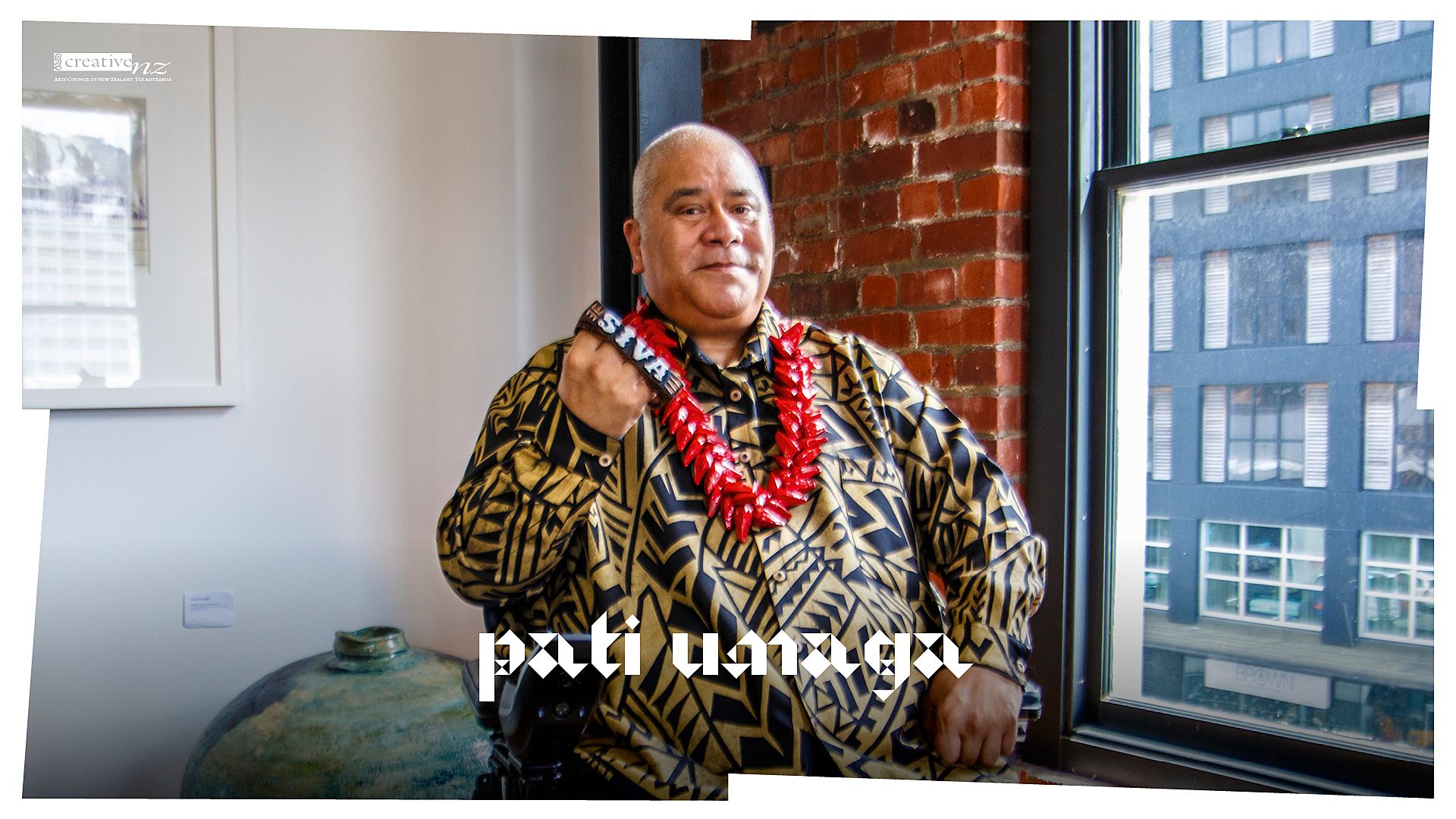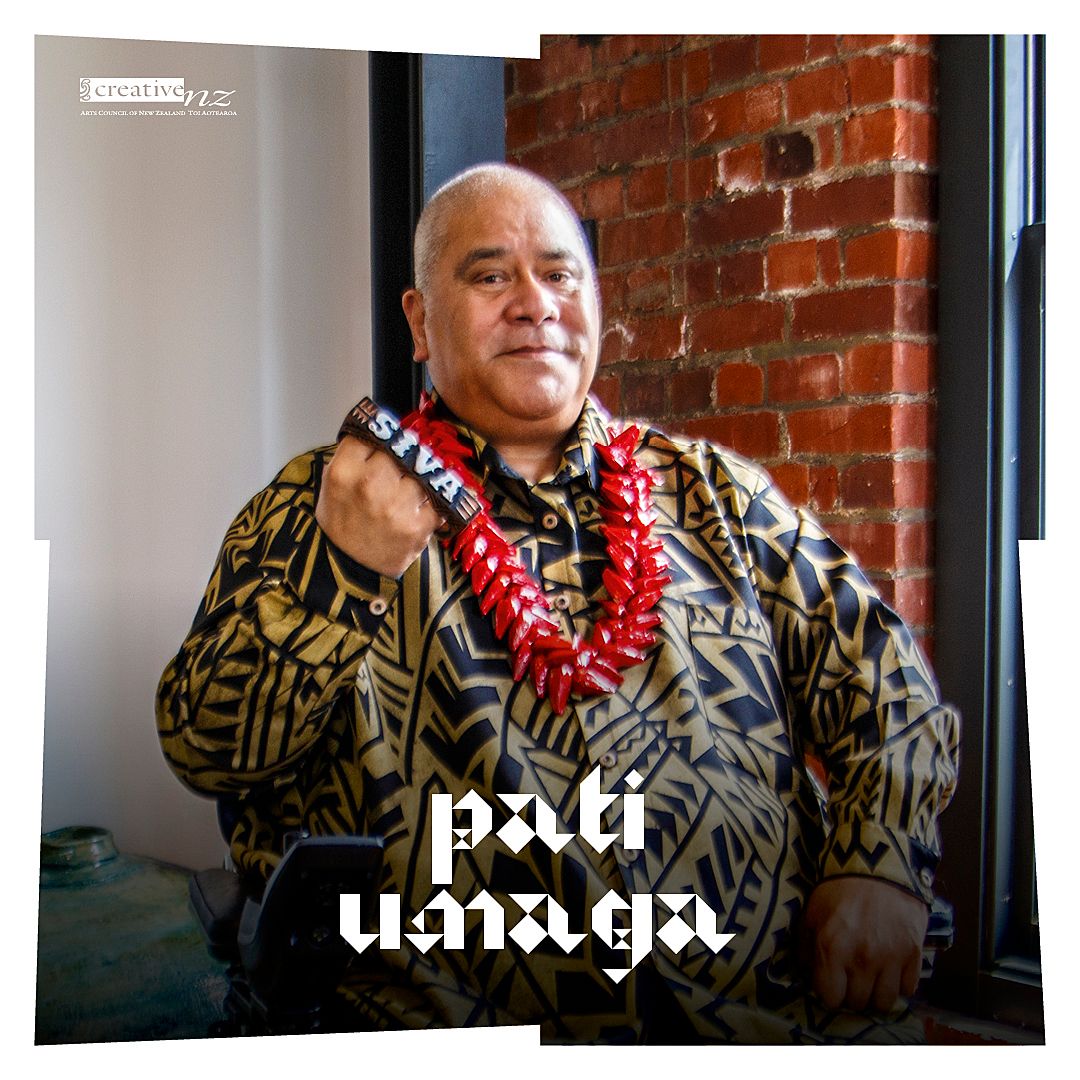By Disabled For Disabled: Making Space for All Pasefika Artists
Musician Fonoti Pati Umaga shares his journey with disability and how much more our Pacific arts community needs to confront to become truly equitable.
We’re collaborating with Creative New Zealand to bring you the groundbreaking Pacific Arts Legacy Project. Curated by Lana Lopesi as project Editor-in-Chief, it’s a foundational history of Pacific arts in Aotearoa as told from the perspective of the artists who were there.
I never met my paternal grandfather but his name was Pa’u Umaga and he was from the ‘spiritual’ capital of Sāmoa, the village of Leulumoega. He was an orator, a high chief and musical composer; he was also a member of Sāmoa’s Mau independence movement in the 1920s.
The Mau movement was established as a non-violent resistance to colonial rule, insisting on Sāmoa’s independence from the New Zealand Government administration of the time. During a peaceful procession on 28 December 1929 to welcome back exiled Mau leader Alfred Smyth, New Zealand police opened fire, killing 11 people including the Mau spiritual leader Tupua Tamasese Lealofi III. This would come to be known as Black Saturday.
My father, Umaga Tulouna Umaga, once told me how, as an eight year old, he saw granddad running home after that march asking to be hidden somewhere, fearing the New Zealand soldiers who were hunting Mau members down. He told me of a plane with a machine gun and even a spotlight flying around. At the time I thought my father was stretching the truth, only to read Michael Field’s book Mau: Samoa’s Struggle for Freedom later in life and understanding that what my father had seen was actually a Tiger Moth biplane used by the New Zealand Army.
Through it all, music played a big part in my rehab
My grandfather went on to compose one of the anthems of the Mau movement, Pese o le Mau. Sung in two parts in rich baritone and bass male voices, it was an a capella chant that helped explain the mood, the atmosphere and the political climate during the Mau era. It speaks of the events leading up to that fateful Black Saturday massacre, a historical account and perspective that could not be manipulated like future historians’ recollections would, of the same event.
Dad’s recounting of that event and his explanation of my grandfather’s song was an epiphanic moment for me, the first realisation that narratives, historical events, stories and personal experiences could be expressed through music. It created a deep and indelible impression, the significance of which is evident as I ponder the way music and social justice have played a big part in my own life’s journey leading me to this point in time.
This moment also helped me put in perspective why my father sat my brothers and I down as teenagers to tell us we were no longer playing sports but that we were to “be a band”. As children of staunch Sāmoan parents, we never questioned their decisions; even though we were living in a Wellington suburb in the 1970s, the Sāmoan way of strict parental discipline was very much a part of our existence. As one of my brothers used to joke, it was either dad’s way or the highway. Reluctantly my brothers and I formed our family band, Cabasa (later renamed Kabasa), but little did I know just how critical a part that music would play for me and the path it would take me on.
Disability is a human-rights issue
On 26 May 2005 my journey through the world of disability began. That morning I fell while taking a shower, I broke my neck and was relegated to being a wheelchair user for the rest of my life. The three-year path to recovery that followed was filled with depression, drug use, anger and hate towards the world. Yet through it all, music played a big part in my rehab, aiding my ability to emerge out of the dark times and into the light. During this time I went from being paralysed from the neck down unable to move my hands, to slowly returning to playing my beloved bass guitar.
Our family band Kabasa continued to perform gigs, I had friends who were musicians giving me the opportunity to perform alongside them, and despite access issues at the venues, we overcame them to enable me to perform. I became a judge for the Pacific Music Awards and the Waiata Māori Music Awards, I won an Arts Access Aotearoa Arts Leadership Award in 2015 and slowly I was gaining more confidence in myself and my music ability.
In 2015 I composed and recorded a song called ‘SIVA’, while also directing the music video that accompanied it. This project was a way of challenging the notion that we as disabled people could not dance, that we could not express artistic joy and freedom because of our physical limitations or that we could not create quality art and music to share that the world would respond positively to. ‘SIVA’ got recognition within the disability arts community and with arts organisations such as Arts Access Aotearoa.
‘SIVA’ was a great platform for many disabled people from the creative sector to be part of and participate in. This was evidenced during the 2018 Vodafone Pacific Music Awards, where I was privileged to share the stage with Pasifika Phusion 2.0, a troupe of disabled dancers who backed me up as I performed ‘SIVA’ live.
Being witness to the metamorphosis that occurred in these young disabled artists and dancers as they went from feeling apprehensive and nervous at the idea of performing at such a prestigious event, to seeing them after the performance glowing with pride and joy was both inspiring and a highlight. This is a powerful example of dreams and possibilities realised when we nurture the talents and skills of our youth and create opportunities for them to take part. I believe that youth succession should always be fostered and included in all our planning and arts-based activities.
As a Sāmoan disabled musician, artist, advocate and leader, there are still some of the things I would like to achieve. This includes the use of our cultural heritage and arts to capture the narratives and experiences of our most vulnerable in society, our Pasefika disabled. And to have us write our own legacy through music and the arts. The Pasefika disabled community are creative, artistic souls despite the fact our bodies might be broken. Our voices are not heard and our presence is invisible in a society that disables us though attitudinal stereotypes and cultural stigma. The arts, through music, performance, the written and spoken word, are a pathway for us to express ourselves, shining a creative light on our very important and unique viewpoints.
There is still more work to do to get the message to our people
The establishment of the Pacific Toa Award, under the Creative New Zealand Pacific Arts Strategy, is a huge milestone and achievement for our Pasefika disabled arts community and provides us with a cultural platform to be in control of our arts destiny. But there is still more work to do to get the message to our people, to encourage them to come forward and embrace what can be achieved as Pasefika disabled people in the creative arts sector.
My long-term dream for our Pasefika disabled arts and artists is to build a village that is fully accessible and inclusive of all people with disabilities, whether visible or ‘invisible’. It would be a village run and managed by disabled, where we would house fully adapted equipment and tools within a venue for the creative development of our disabled artists. Somewhere we can write our own history, create our own legacies, develop a succession pathway for our youth, to explore our further journeys and capture more of our narratives through the arts to share with the world.
I also imagine a Pasefika Toa Disability Arts Festival, a national event that would feature disabled artists and performers across all formats of the arts at fully accessible venues and would include New Zealand Sign Language interpreters, audio description and disability-friendly activities led by the disabled to be shared with our wider community. This would be a place where we could connect to international festival networks and invite overseas disabled artists to perform and participate in workshops with our local artists and community.
I also imagine a Pasefika Toa Disability Arts Festival
Disability is a human-rights issue, not one of health, and while there are government policies and programmes that are specific to disability, there is no voice at the table or representation from Pasefika disabled people in developing or implementing those policies. Therefore, nothing is more critical than having strong leadership from our disabled people to lead their own change, By Disabled For Disabled. The arts feed, develop and create an alternative leadership pathway for us to lead our own change and to advocate on our own behalf.
While there is so much happening in the disability space, there is more that needs to be done to encourage our wider Pasefika disabled people to come forward, to be included and participate in the conversations and engagements taking place with other disabled individuals and organisations.
It saddens me to see the lack of Pasefika disabled people engaging in high-level strategic and governance policies, as these currently have ultimately little effect or add no change to our lives. Given the traditional methods of attending formal meetings, forums or conferences, advisory groups and committees, or taking part in surveys or assessments, few of which are attractive or appealing to our people, this is not surprising.
For our Pasefika disabled, the arts are crucial, not only as a pathway for building leadership and advocacy but also for capturing our journeys and experiences, to document and acknowledge our history so we can define and design our future.
cnz
This piece is published in collaboration with Creative New Zealand as part of the Pacific Arts Legacy Project, an initiative under Creative New Zealand’s Pacific Arts Strategy. Lana Lopesi is Editor-in-Chief of the project.
Series design by Shaun Naufahu, Alt group.
Header photo by Pati Solomona Tyrell.


